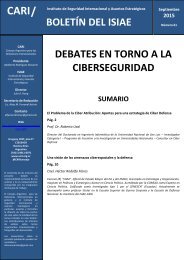Emulating Code In Radare2
lacon2k15-esil
lacon2k15-esil
- No tags were found...
Create successful ePaper yourself
Turn your PDF publications into a flip-book with our unique Google optimized e-Paper software.
<strong>Emulating</strong> <strong>Code</strong> <strong>In</strong> <strong>Radare2</strong><br />
pancake<br />
Lacon 2015
Overview<br />
Emulation allows us to simulate the execution of code of the same or different CPU in<br />
order to understand what a specific snippet of code is doing or avoid the common risks<br />
running native code have (malware, etc).<br />
This technique have been used to run games from old consoles.<br />
But there have been used too in debuggers and code analyzers in order to ease the<br />
understanding
Overview<br />
But it’s in fact way more than just this.<br />
- CPU / FPU<br />
- MMU (pagination, permissions, ...)<br />
- Exceptions, Traps, Etc<br />
- Syscalls<br />
- System Libraries<br />
- Devices
Understanding the problem<br />
Emulate CPU<br />
Requires lot of archspecific<br />
code that needs to<br />
be rewritten for each<br />
architecture, and if we<br />
want to be really finegrained<br />
for each CPU<br />
model.<br />
Performance<br />
This is important to run<br />
games, or huge pieces of<br />
code (like an entire<br />
operating system).<br />
Implies JIT and increases<br />
security risk.<br />
<strong>In</strong>termediate Language<br />
Emulators are usually<br />
implemented at low level,<br />
and that makes internal<br />
representation not<br />
available for deeper<br />
analysis of code.
How To Solve All Those Problems?<br />
Just use R2… but how?
Strings
Evaluable<br />
Strings<br />
<strong>In</strong>termediate<br />
Language<br />
I defined a forth-like programming<br />
language to describe what every<br />
instruction of every CPU does. Some<br />
kind of micro-code.<br />
It can be extended with native plugins<br />
to create new commands, hook on<br />
events, implement syscalls, etc
Strings are human-friendly.<br />
Why<br />
Strings?<br />
Easy to generate, parse and modify.<br />
Extensible by definition.<br />
Can be redefined by the user.<br />
Easy to translate to other forms.
How Does It Look?<br />
sub rsp, 0x648<br />
1608,rsp,-=,$c,cf,=,$z,zf,=,$s,sf,=,$o,of,=
Easy To Translate: REIL<br />
ESIL is managed in r2 with the `ae` command.
Other Translations<br />
Radeco is the experimental decompiler for r2, it<br />
is written in Rust, as part of the GSoC-2015, and<br />
performs several computations like SSA, DCE,<br />
Constant Propagation and Verifications and can<br />
output the results in C-like form or graph.
Current Applications For ESIL in <strong>Radare2</strong><br />
● Emulate a block of code<br />
<strong>Code</strong> Emulation<br />
● Used in real malware samples to decrypt<br />
Search Conditions<br />
Branch Prediction<br />
Assisted Debugging<br />
VM Emulation<br />
●<br />
●<br />
●<br />
●<br />
●<br />
●<br />
●<br />
●<br />
Evaluate an ESIL expression on every offset<br />
Useful for complex conditionals in exploiting<br />
Linear emulation: e asm.emu<br />
Catch data refs, conditional branch, reg calls..<br />
Implements Software Watchpoints<br />
Step in every instruction and evaluate ESIL<br />
Fully emulates Baleful VM<br />
Can easily support Themida or ZeusVM
Current Applications For ESIL in <strong>Radare2</strong><br />
<strong>Code</strong> Analysis<br />
Decompilation<br />
●<br />
●<br />
●<br />
●<br />
a2f<br />
Used in real malware samples to decrypt<br />
Creates AST from ESIL<br />
Feeds the passes with info from r2<br />
And More! ● ...
Expression Dependencies<br />
Registers<br />
This is handled by the r_reg API from r2.<br />
Memory<br />
Served by the r_io API.<br />
●<br />
●<br />
●<br />
●<br />
Profile defined in plain text, supports<br />
packed register, overlapped, bitfields,<br />
and more!<br />
Reimplemented in Rust for Radeco.<br />
Each expression needs to know the<br />
offset where it is.<br />
ESIL have its own internal registers<br />
prefixed with ‘$’<br />
●<br />
●<br />
●<br />
●<br />
●<br />
●<br />
Virtual/Physical addresses<br />
Page protections and exceptions<br />
Allows to map different files and data<br />
at different virtual addresses.<br />
Emulate the Stack, Heap and BSS<br />
Loaded from RBin by default.<br />
io.cache to avoid real memory writes
Hooks<br />
ESIL API permits to hook on<br />
every internal step of the<br />
expression evaluation.<br />
●<br />
●<br />
●<br />
●<br />
●<br />
●<br />
register read / write<br />
memory read / write<br />
trap / exception<br />
syscalls<br />
scriptable with r2pipe<br />
custom/unknown instruction
Architectures<br />
Does not yet supports all<br />
instructions, but basic ones are<br />
enough for most uses, and grows<br />
every day a bit depending on user<br />
needs.<br />
● Arm, Thumb, Aarch64<br />
● Mips<br />
● GameBoy/z80<br />
● Powerpc<br />
● 8051<br />
● 6502<br />
● Avr<br />
● X86 (32, 64)<br />
● Brainfuck<br />
● Baleful<br />
● H8300
Alternatives?<br />
Last Blackhat, the Capstone guy<br />
presented the Unicorn project that<br />
aims to be like ESIL:<br />
●<br />
●<br />
●<br />
●<br />
●<br />
●<br />
●<br />
●<br />
●<br />
●<br />
●<br />
Using qemu as code base (not in sync)<br />
GPL (licensing problems)<br />
Provides API and bindings (Go, Java, Py)<br />
Cannot emulate dynamic VMs<br />
Uses JIT (-secure, +slower, complexity++)<br />
Not yet released<br />
Register profiles are static<br />
Emulates MMU with generic io api<br />
No IL access<br />
No memory cache<br />
Hard to implement new archs
Unicorn Also Works in R2 (radare2-extras/unicorn)
Demo Time!<br />
e asm.emu=true<br />
cd radare2-bindings/r2pipe/nodejs/examples/syscall<br />
-> emulates shellcode + syscalls using r2pipe and esil
Thanks For Listening!<br />
Questions?




